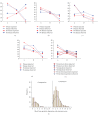Predicting successful aging in a population-based sample of georgia centenarians
- PMID: 20885919
- PMCID: PMC2946582
- DOI: 10.1155/2010/989315
Predicting successful aging in a population-based sample of georgia centenarians
Abstract
Used a population-based sample (Georgia Centenarian Study, GCS), to determine proportions of centenarians reaching 100 years as (1) survivors (43%) of chronic diseases first experienced between 0-80 years of age, (2) delayers (36%) with chronic diseases first experienced between 80-98 years of age, or (3) escapers (17%) with chronic diseases only at 98 years of age or older. Diseases fall into two morbidity profiles of 11 chronic diseases; one including cardiovascular disease, cancer, anemia, and osteoporosis, and another including dementia. Centenarians at risk for cancer in their lifetime tended to be escapers (73%), while those at risk for cardiovascular disease tended to be survivors (24%), delayers (39%), or escapers (32%). Approximately half (43%) of the centenarians did not experience dementia. Psychiatric disorders were positively associated with dementia, but prevalence of depression, anxiety, and psychoses did not differ significantly between centenarians and an octogenarian control group. However, centenarians were higher on the Geriatric Depression Scale (GDS) than octogenarians. Consistent with our model of developmental adaptation in aging, distal life events contribute to predicting survivorship outcome in which health status as survivor, delayer, or escaper appears as adaptation variables late in life.
Figures



References
-
- Oeppen J, Vaupel JW. Demography—broken limits to life expectancy. Science. 2002;296(5570):1029–1031. - PubMed
-
- Poon LW, Perls TT. Biopsychosocial Approaches to Longevity. New York, NY, USA: Springer; 2008.
-
- Evert J, Lawler E, Bogan H, Perls T. Morbidity profiles of centenarians: survivors, delayers, and escapers. Journals of Gerontology. Series A. 2003;58(3):232–237. - PubMed
Grants and funding
LinkOut - more resources
Full Text Sources

